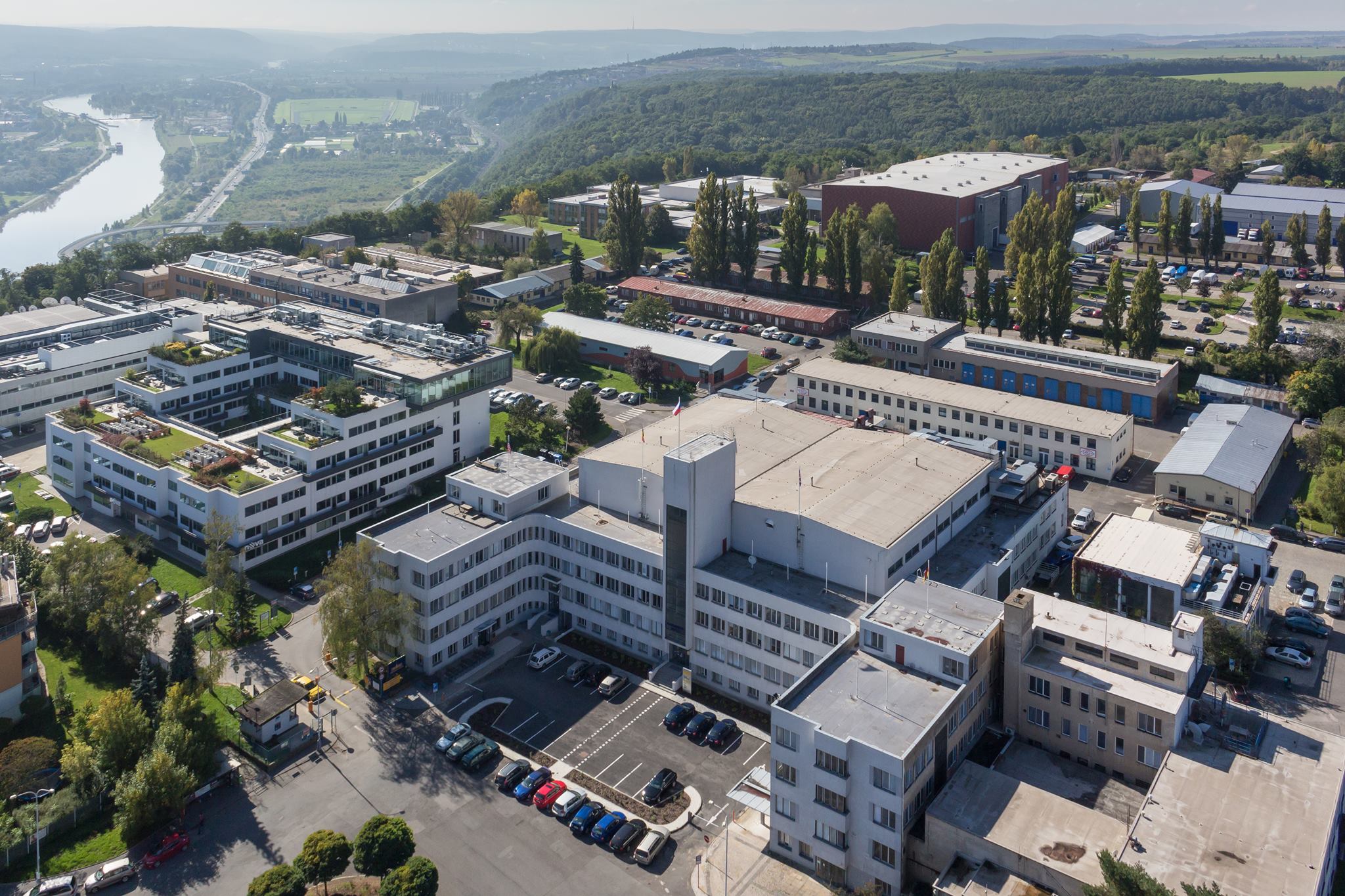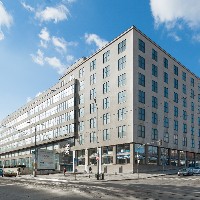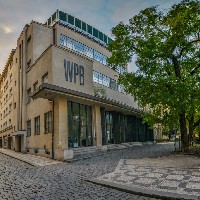Breadcrumbs navigation
Functionalist Prague
Most people think of Prague as a city of historic and period historical architecture, giving it an unmistakably romantic character. Yet Prague is rightly regarded as one of the leading centres of more modern architecture, which, while aesthetically distinctive, has became an inherent aspect of the city. The two inter-war decades were marked by the biggest architectural boom, both here and in other major Czech cities. Czechoslovakia was then a young, liberal-democratic country open to various architectural trends, including Avant-Garde Functionalism, which left its indelible and positive mark on the face of the city.
Functionalism
Functionalism began to assert itself here in the 1920s, with a simplicity verging on the austere, contrasting with the ornate Art Nouveau period prevalent at the turn of the century. Indeed, the major emphasis of Functionalism was on the functionality and effectiveness of buildings, which governed their form. The most important representative of Functionalism was the Swiss architect Le Corbusier, who undertook the Baťa project in Zlín. This came to be a showcase of the new building style within the country and was the pride of the young Republic. Other major cities, Brno and Prague, were not to lag behind, and a number of Functionalist gems were designed and built, admired worldwide.
In Prague you'll come across Functionalism almost at every turn. It has been used in many architectural remits, from private and residential construction to church architecture. The following selection gives some of the best examples of this timeless style that Prague has to offer.
Villa Müller
Probably the most famous Functionalist building in Prague is Villa Müller in Střešovice. At first glance an austere cube, with a façade brightened only by yellow window frames, this was a shocking and hard-to-accept construction at the time. The building's unique original interior makes the house one of Prague's true architectural gems. The author of the design was the most significant Czech representative of Functionalism, Adolf Loos. Here, he presented his revolutionary concept, which he called by the German word 'Raumplan' i.e. the spatial arrangement of the house and the elevations of the rooms according to their function. His use of exceptional materials and colour-schemes was quite unlike anything seen before. The interior is complemented by original furniture, also designed by Loos. Villa Müller is under the stewardship of Prague City Museum, and visits can be booked on the museum website.

Winternitz Villa
Loos revisited his distinctive use of space in a subsequent design, the Winternitz Villa in Prague's Smíchov district, which was also the last project completed in his lifetime. Unfortunately, unlike the Müller Villa, here the original interiors and furnishings have not survived. After 1989 the villa was returned to the descendants of the original owners and has been open to the public since 2017. It can be viewed by guided tours or when it hosts cultural events.
Baba Colony
One truly outstanding concept in the history of Czech and European Functionalism is the Baba Colony of residences. It was established as one of Europe's exemplary modern lifestyle suburbs. Between 1932 and 1940, a total of 33 villas of different kinds grew up here. The author of the urban design was the well-known architect Pavel Janák, and the individual houses were also designed by other Czech architects, such as Josef Gočár, Ladislav Žák, and others. One of the villas is the work of the only participating guest from abroad, the Dutch architect Mart Stam. Numerous dignitaries and popular figures of the time chose to have their villas built here, notably the graphic designer Ladislav Sutnar, the painter Cyril Bouda, the historian Karel Herain, and the then director of the National Theatre, Stanislav Mojžíš. Thanks to its distinctiveness, the Baba Colony has been an Urban Heritage Zone since 1993 and has recently been added to the European Heritage List.
Barrandov
A similar project began a few years earlier in Barrandov. The idea of a garden city suburb in Prague was the brainchild of Václav Maria Havel, a businessman and builder. He was inspired by his visit to the USA, specifically to San Francisco, where a residential neighbourhood for California tycoons fired his imagination, as did the Cliff House restaurant on a promontory above the ocean, which was later to serve as the model for the Terasy Barrandov viewpoint restaurant. Having decided to bring a touch of America to Prague, he chose the rocky outcrop above the Vltava River on the southern edge of Prague as the ideal location to turn his idea into reality. Unfortunately, the large-scale project was never quite completed as intended. In its initial stage, the villas built here were predominantly Functionalist, but the later houses are in a more romantic style. Prague's high society was drawn to this attractive location on the rocky promontory above the Vltava River, close to the Barrandov Film Studios, whose main building is also a great example of Functionalism. Many from the film industry and a whole host of artists had their houses built here. Barrandov thus became a kind of Czech Hollywood.

The Barrandov residential area was dominated by the aforementioned bright white Functionalist restaurant building with its glazed observation Barrandov Terrace towering over the river. Soon after its completion it became a popular destination for Praguers, who came here for entertainment, and later, sports activities. Havel had a modern swimming pool built in the former stone quarry, the first such 50-metre pool in the country. The restaurant building architect was Max Urban, also the man behind the design of the Barrandov villa suburb. The building sprang up in just six months. The main building was joined by a complex of terraces that followed the undulating outline of the cliff. In 1937 the Trilobit bar was added, a timber construction. Unfortunately, the building dilapidated since the 1960s and the timber lodge bar burned down a few years ago. The swimming pool has also gone, only the diving tower remains. The building's latest owner began a remodelling recently to turn it into a modern hotel, which will significantly alter the look of the terraces. Fortunately, the original building has been saved.
Skleněný palác
Between the wars a number of apartment buildings were built here among the private residences, distinguished by exceptional quality and staying true to the principles of Functionalism. One of these is the monumental apartment house for Zemská Bank in Bubeneč. Thanks to its frontage, where glass bands of windows and conservatories alternate with bands of ceramic tiles, it is known as the Skleněný palác, the 'Glass Palace'. The project design is by the excellent architect Richard Ferdinand Podzemný, who also took part in designing the Podolí swimming stadium. The apartment house offered a high standard of living. The luxury apartments featured a number of technical luxuries ahead of for their time, such as underfloor heating or built-in wardrobes. Great attention was paid to the purposeful use of the communal areas of the house, from the basement to the courtyard and the roof. There were underground garages, a tennis court and a roof terrace for recreation.
Molochov
An unmissable reinforced concrete block of apartment buildings from the late 1930s stands directly opposite the Letná plain, lacking the elegance of the Glass Palace, which has earned the biblical nickname Molochov to mark its brutish robustness. It seems more in keeping with early prefabricated houses. Yet living here provided a level of comfort unusual for this type of housing. The apartments included rooms for maids, cloakrooms, and some apartments spanned entire floors. The building's ground floor was reserved for trade. After the communist coup in February 1948, these luxury apartments came to house numerous communist bigwigs. Since the 1960s, the building has been heritage listed.
Trade Fair Palace
Once the largest building of its kind in the world, the Trade Fair Palace, is now part of the National Gallery Prague. It was built between 1925 and 1929 to a design by architects Oldřich Tyl and Josef Fuchs, and served its original trade-fair purpose until 1951. The building of momentous proportions has 8 above-ground and 2 underground floors, and extensive exhibition halls. The impressive atrium lobby is lined with observation galleries and runs up through all the floors. These are connected by the delicate-seeming structure of a glass elevator, itself a work of art. Although the palace seems a perfectly regular building, you will not find a single right angle here. In 1974 the building was almost destroyed by fire and had to undergo demanding refurbishment. The Trade Fair Palace did not reopen to the public for another 20 years, and then as an exhibition space for the National Gallery Prague, which put its extensive collections of modern and contemporary art on display here.

Edison Transformation Station
The elegant Edison Transformation Station building is located right next to St Henry's Church and the Jubilee Synagogue. It was designed and built for Prague Electrical Enterprises between 1926-1930 by architect F. A. Libra. Surprisingly, this unique cascaded building is not a reinforced concrete construction. Only the ceilings are concrete, the walls are brick. Each floor has its own particular floor plan and its own terrace. There is a double frontage with a gap of almost half a metre between the outer façade and the actual front of the building, to provide natural ventilation and air cooling of the oil-immersed transformers. The building served as a transformer station until the 1990s. Its remarkable reconstruction brought a multifunctional space, which today houses a cosy cinema with a stylish café, the Edison Filmhub.
Baťa Palace
The seven-storey Baťův dům obuvi (Baťa Palace) from 1929 is situated at the lower end of Wenceslas Square and still serves its purpose today. Thanks to the façade consisting of several rows of large-format windows, it was also called 'the Glass House'. In its time it was the most modern department store in its European context. The building is considered one of the most significant buildings of Czech Functionalism.
Mánes
The multifunctional building of the Mánes Association of Fine Artists was built in 1930 on the site of the former Šítkovské Mills, and remains one of the most interesting examples of the style. The complex, which now houses the Mánes Exhibition Hall, connects the Masarykovo nábřeží embankment with the southern part of Slavonic Island. The project was the brainchild of architect Otakar Novotný, who put the building on top of a reinforced concrete bridge arching over an arm of the Vltava River, to achieve the effect of a free-flowing river beneath. The building, essentially a low-rise block with glass surfaces and a smooth light-coloured frontage makes an interesting contrast with the dark stone wall of the Renaissance Šítkovská věž tower it adjoins.

Prague Electrical Enterprises
The Prague Electrical Enterprises building in Holešovice dating from 1927-1935 by architects Adolf Benš and Josef Kříž dominates the Holešovice waterfront. The large complex was designed as a multifunctional house consisting of several buildings for a variety of purposes. In its time the building was equipped with novel modern technologies, such as air conditioning. The horizontally articulated façade is once again comprised of glass surfaces and ceramic tiles. One point of note is how the façade of the building shone at night, due to a special phosphorescent coating applied to the ceramic cladding. This was probably why the building was given a green coat of paint during the war, to preclude air strikes.
National Technical Museum / National Museum of Agriculture
The monumental building of the National Technical Museum on Letná was built together with its neighbouring and almost identical twin the National Museum of Agriculture in 1938-1941 to the design of architect Milan Babuška. The building, with its distinctive neoclassical elements, is an example of the so-called International style, i.e. late Functionalism. The building layout is U-shaped; between two shorter wings, which jut perpendicularly out from the corners of the frontage, is a courtyard measuring 70 x 25m, with three galleries designed for the largest, transport-related exhibits – aeroplanes, locomotives and cars.
Church of St Wenceslas
No overview of the best mostly inter-war Functionalist buildings in Prague would be complete without mention of the first reinforced concrete church in the country. It is the Church of St Wenceslas in Vršovice designed by Josef Gočár. The generously dimensioned structure makes perfect use of the sloping terrain, resonating with the stepped roof and lighting of the church nave, through bands of lateral windows. The light intensity grows as we get closer to the altar. The most striking feature of the building is a slender, 80m high prismatic bell-tower, crowned with a tall yellow cross, floodlit after dark.

text: Prague City Tourism


